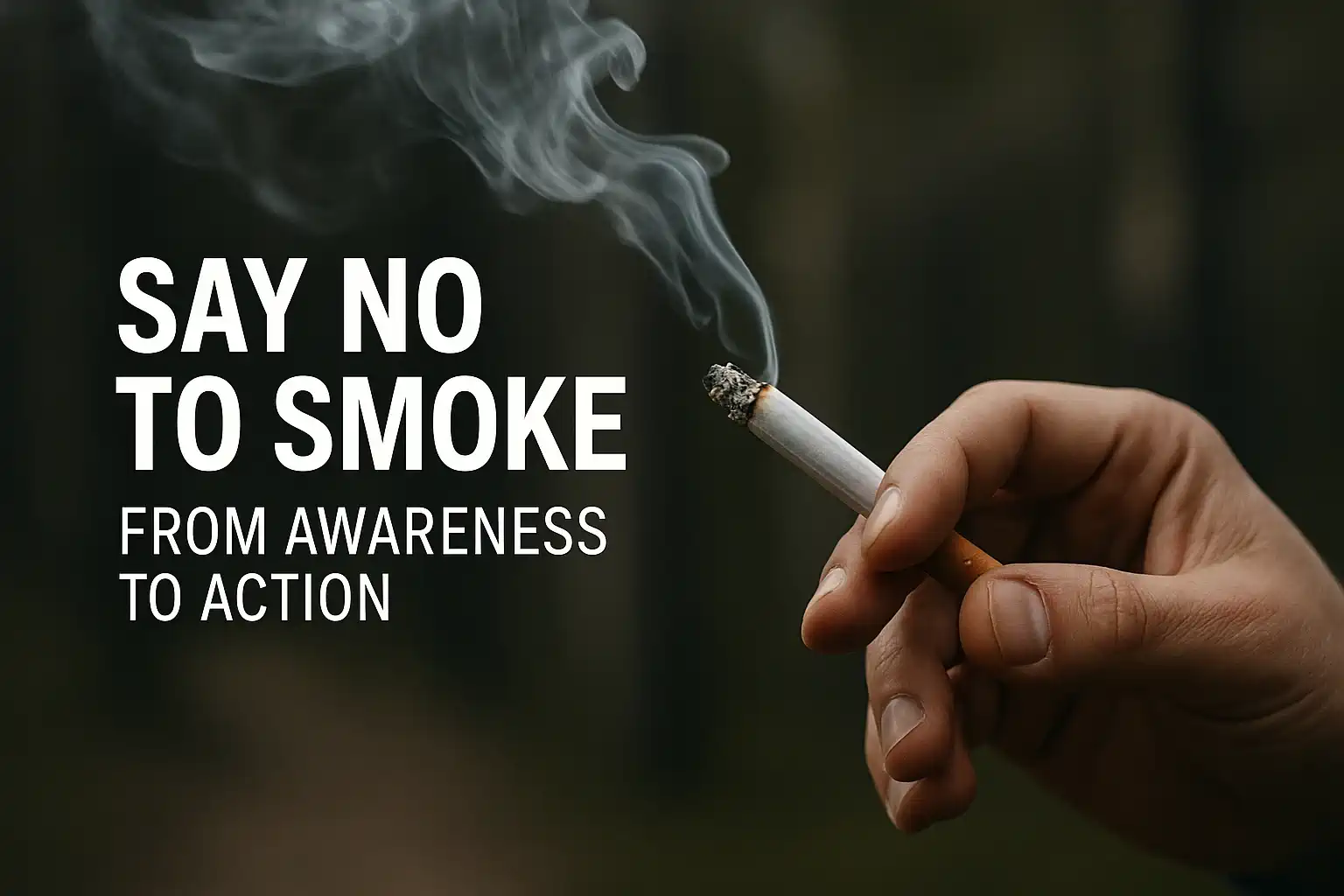Table of Contents
ToggleEmpowering Youth Through Awareness
Each puff of tobacco may seem small, but its impact is vast on health, society, and generations to come. As the world marks World No Tobacco Day 2025, we’re reminded of the urgent need to protect our youth from one of the most preventable causes of death worldwide: tobacco use. Encouraging young people to quit smoking is not just a health choice, but a life-saving intervention.
While much has been done in the fight against tobacco, a dangerous shift is taking place. The tobacco industry, now equipped with psychological insights and modern marketing tactics, has its sights set on young, impressionable minds. From sleek vapes to flavored nicotine products, these modern disguises mask a centuries-old killer. The sooner one chooses to quit smoking, the greater the chances of reversing the damage caused by these harmful products.
Recognizing this threat, Tech Mahindra SMART Academy for Healthcare, Pune, hosted a thought-provoking webinar titled “Say No to Smoke – From Awareness to Action.” The session, led by Dr. Madhu Oswal, shed light on how the developing adolescent brain is being targeted and how knowledge, early education, and youth empowerment can be our strongest weapons in this fight. One of the key messages: it’s never too early to talk about the importance of quitting smoking.
This blog captures the key takeaways from the session, exploring not just the science of vulnerability but also the strategies of prevention, policy awareness, and the undeniable power of youth in building a tobacco-free future.
Why Tobacco Targets the Young: The Science of Vulnerability
The human brain continues to develop until the age of 25, especially the prefrontal cortex, which governs judgment, decision-making, and impulse control. This makes adolescents and young adults particularly susceptible to risk-taking behaviors, including experimenting with tobacco. Helping teens understand the benefits of quitting smoking early can protect this vulnerable stage of development.
The tobacco industry knows this and exploits it. Marketing campaigns are designed to manipulate young minds by associating smoking or vaping with freedom, adulthood, glamour, and rebellion. Whether it’s through colorful packaging, flavored products, or social media influencers, the message is clear: tobacco use is cool. But the reality couldn’t be further from the truth.
Forms of Tobacco Use in India: More Than Just Cigarettes
Tobacco use in India is multi-faceted and deeply embedded in culture. While cigarettes and bidis remain common, smokeless tobacco products such as gutka, pan masala, khaini, and snuff are equally, if not more, harmful. These products are often perceived as “less dangerous” but carry the same risks of oral cancer, gum disease, and addiction.
Emerging trends such as vaping, e-cigarettes, and nicotine-laced gummies pose new challenges, particularly among urban youth. These products are often marketed as “safer alternatives” despite containing addictive nicotine and harmful chemicals.
Raising awareness about these trends is essential to help youth make informed choices and quit smoking before addiction takes hold.
The Health Toll: A Life Derailed by Tobacco
The health consequences of tobacco use are devastating. It affects almost every system in the body, leading to:
- Oral issues like stained teeth, gum infections, and bad breath
- Lung diseases such as COPD and chronic bronchitis
- Cardiovascular problems, including heart attacks and strokes
- Reduced reproductive health, affecting fertility in both men and women
- Increased risk of various cancers, especially oral and lung cancer
- Dangers of second-hand and third-hand smoke, which can harm non-smokers especially
children and the elderly simply by being in the same room or touching contaminated surfaces.
For those already impacted, the first step toward recovery is to quit smoking and seek support.
Marketing Manipulation: How Industries Use Brain Science Against Us
One of the most eye-opening segments would be knowing how industries tobacco, alcohol, gaming, social media, and even junk food intentionally exploit the developing adolescent brain. By triggering the brain’s reward centers and suppressing its judgment systems, they make harmful behaviors feel “good” in the short term, despite their long-term risks.
This manipulation is deliberate, well-funded, and deeply rooted in consumer psychology. It is “legal brain hacking”. An urgent need for critical thinking and media literacy in schools and colleges is the need of the hour.
Empowering children to quit smoking through education is one way to break this manipulation cycle.
Prevention Strategies: ACE Your Response
The ACE Strategy to empower youth to resist peer pressure and make informed choices:
- Avoid: Stay away from situations or people that might encourage tobacco use
- Cope: Use healthy coping strategies like sports, art, or journaling to deal with stress
- Escape: Know when to walk away from harmful environments or conversations
The value of assertive communication is encouraging students to practice saying “no” with confidence and clarity.
Understanding Tobacco Laws in India
India has made significant strides in tobacco control with laws like COTPA (Cigarettes and Other Tobacco Products Act), pictorial health warnings, bans on advertising, and restrictions on tobacco sales near schools. The 2019 ban on e-cigarettes was a landmark move.
However, enforcement remains a challenge. Community involvement and youth participation is needed to ensure these laws serve their intended purpose.These legal frameworks can be powerful tools when combined with grassroots efforts to help individuals quit smoking.
The Power of Youth: From Bystanders to Changemakers
The young people are not just at risk they’re also the solution.
- Be positive peer influencers.
- Start awareness campaigns in their communities.
- Support friends or family members trying to quit.
- Share verified information about the harms of tobacco.
Quitting tobacco is not easy, but it’s possible with support. Behavioral therapy, nicotine replacement options, and community engagement have shown success in helping people kick the habit. Creating peer support networks can be a game-changer for those trying to quit smoking.
Education as a Tool for Prevention
The importance of early education, beginning as early as age 3 or 4, to shape attitudes before harmful behaviors begin. Programs like these webinars can plant the seeds of awareness that grow into lifelong healthy choices.
Final Thoughts: Say No to Smoke, Say Yes to Life
The fight against tobacco is not just the government’s or the doctor’s job it’s everyone’s. As we observe World No Tobacco Day 2025, let this be a reminder that saying no to tobacco is saying yes to:
- Better health
- Clearer thinking
- Longer life
- A cleaner environment
- A stronger, smoke-free generation
Let’s carry this message forward in our classrooms, communities, and families. Together, let’s inspire action and encourage more people to quit smoking — for themselves and for future generations.


